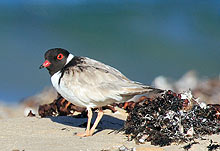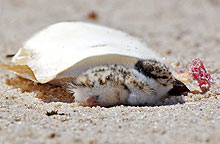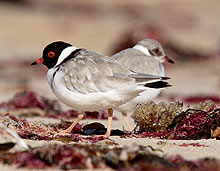Birds in the Hood
Dr Grainne Maguire
Birds Australia‘s Beach nesting Birds Project Officer
Each spring and summer our ocean beaches become the nesting grounds of a threatened bird – the Hooded Plover. Who would have thought that a bird would choose to nest on the sand at a time of year when there are so many people visiting the beach? It might seem like an unintelligent thing to do, but these birds are nesting closest to their food source because when the eggs hatch, the chicks need to start feeding straight away and can’t travel very far on their tiny legs.
The beach and dunes are also a great place to camouflage the nest because the three tiny eggs (the size of twenty cent coins) are speckled grey and brown to blend in perfectly with the grainy sand. A predator has to search long and hard to discover the eggs, giving them a good chance of survival. The one thing that Hooded Plovers did not evolve with was the enormous number of people that flock to the beaches during their nesting season. Encroaching coastal developments and changes to the dune environment leave the Hooded Plovers little room to adapt to our presence. |

Adult hooded plover
Image courtesy Glenn Ehmke |
While the tide might wash out a nest, a seagull or magpie might eat the eggs, or a kestrel might swoop down and take a chick – these natural threats have never been frequent or severe enough to threaten the survival of the species. However, the impact of people has greatly upset the balance and Hooded Plovers, Victoria’s only exclusive beach-nesting birds, are now faced with extinction. Only 400 are left on our coast – already the species has become extinct in Queensland and Northern NSW, and only 50 birds remain in Southern NSW. Last year during spring and summer, 180 birds were monitored by Birds Australia volunteers as part of a statewide project aimed at improving their survival. Of 353 eggs that were laid, only 35 chicks survived, and this wasn’t without effort from land managers and local community members. Such poor breeding success cannot sustain population numbers. These tiny, yet tubby, charismatic black and white birds need our help to survive!
|
Hooded Plovers lay two to three eggs directly on the sand in a shallow nest scrape either on the beach above the high-tide mark or in the dunes. The male and female take turns sitting on the eggs, spending the entire day and night keeping the eggs at the right temperature. They do this for 28 days, and then spend another five weeks watching over their chicks. Hooded Plover chicks cannot fly during this time and need to roam the beach and rock platforms in search of food. In total, the nesting cycle takes 63 days. |

Chick hiding by cuttlefish
Image courtesy
Glenn Ehmke |
The eggs can be stepped on by people and dogs that wander above the high-tide mark and in the dunes. The birds will come off their nest when a person or animal approaches within about 60m and won’t return until that person or animal is gone. When the eggs are unattended, they can be buried in strong winds or bake on the hot sand. The birds tend to be very wary of unleashed dogs, particularly as they have to keep an eye on both the dog and person moving separately from one another. Even if you’re dog isn’t the type to chase the birds, they will have encountered dogs that have chased them and therefore perceive them as a threat. This means that adults can spend a long time away from the eggs when dogs are running on the beach nearby.
At the chick stage, the tiny chicks are easily stepped on by people or animals moving above the water mark because they can’t fly and are incredibly hidden when they crouch by seaweed. When disturbed, the parents leave the chicks to try and distract people or dogs away while the chicks are in hiding. This leads to two common ways for the chicks to die, either through starvation or exposure from too long in hiding, or a predator can come and eat them because the parents are busy distracting us away! Remember that this happens every time a person or dog passes, so with every encounter, the chances of a chick dying increase.
|
In 2006, Birds Australia began the ‘promoting coexistence between recreationists and beach-nesting birds’ project, funded by the Australian Government’s Natural Heritage Trust and hosted by Port Phillip and Westernport Catchment Management Authority. This project is aimed at improving the breeding success of beach-nesting birds by identifying the most effective ways of protecting nest sites.
A major part of this project is involving community volunteers in monitoring nests and setting up signs and fences to protect nest sites, and working in close association with land managers to do this. Local primary schools have become involved and have even built artificial shelters which offer chicks a safe hiding place on beaches
.
It is possible to enjoy a day at the beach in spring and summer, and not be a threat to these birds, by remembering to:
- Keep an eye out for Hooded Plovers and if you see one, walk on another 100m down the beach before settling.
- There might be signs or fences on the beach pointing out that you are near an active nest – please avoid this area and follow what the signs say.
- Walk close to the water’s edge.
- Walk your dog on a lead; this applies to dogs that don’t chase just as much as dogs that like to chase – this is to reduce the impacts of disturbance.
- Never sit in front of a signed area.
- Stay clear of the dunes.
For further information on the Hooded Plover, visit the Birds Australia website: www.birdsaustralia.com.au You can also get involved as a local volunteer, assisting with monitoring the birds and educating the local community. Contact Dr Grainne Maguire email: g.maguire@birdsaustralia.com.au or phone (03) 9347 0757 |

Adult hooded plover with a fledged chick (one of the project's success stories: intensive effort was put in to protect this nesting site at Portsea
Image courtesy Glenn Ehmke |
| |
| |
|




